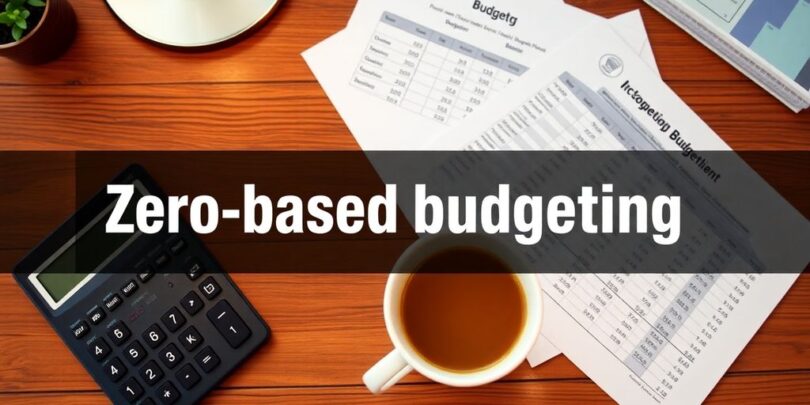Zero-Based Budgeting (ZBB) is a budgeting approach that starts from scratch each period, requiring every expense to be justified. This method has gained popularity not just among businesses but also among individuals and families looking to take control of their finances. In this article, we’ll explore what zero-based budgeting is, how it works, its benefits, and some challenges you might face when implementing it.
Key Takeaways
- Zero-Based Budgeting means every dollar you earn is assigned a specific purpose.
- This budgeting method can help you avoid unnecessary spending and manage your finances better.
- ZBB requires you to reassess all expenses each budgeting period, not just new ones.
- Flexibility is a key feature, allowing you to adjust your budget as your financial situation changes.
- It’s suitable for both personal finance and business applications, making it a versatile tool.
Understanding Zero-Based Budgeting

Definition of Zero-Based Budgeting
Okay, so what exactly is zero-based budgeting (ZBB)? Basically, it’s a way of creating a budget where you start from scratch each time. Instead of just tweaking last year’s numbers, you justify every single expense. Think of it as building your budget from the ground up, every single time. It can be a bit more work, but it forces you to really think about where your money is going. It’s not just for businesses either; individuals and families can use it too.
History and Origin
So, where did this whole zero-based budgeting thing come from? Well, it popped up in the late 1960s. A bloke named Peter Pyhrr, who was working at Texas Instruments, came up with the idea. It was a way to get a better handle on company expenses and make sure every dollar was being spent wisely. It gained some traction in the business world and even made its way into government circles for a while. It’s been around the block, that’s for sure.
Key Principles of Zero-Based Budgeting
There are a few key ideas that underpin zero-based budgeting. It’s not just about starting from zero; it’s about a whole mindset. Here are some of the main things to keep in mind:
- Justification: Every expense needs a solid reason for existing. No free rides!
- Prioritisation: Rank your expenses based on how important they are. What’s a must-have, and what’s a nice-to-have?
- Analysis: Really dig into the details. Understand the cost drivers behind each expense.
- Decision Packages: Break down each activity or expense into smaller "packages" that can be evaluated and ranked.
Zero-based budgeting is all about questioning the status quo. It’s about challenging every expense and making sure it aligns with your goals. It forces you to be more strategic and intentional with your money. It’s not always easy, but it can be really effective.
It’s a pretty different approach to traditional budgeting, where you usually just start with last year’s budget and make some adjustments. With ZBB, you’re constantly re-evaluating and making sure you’re getting the most bang for your buck. It’s about managing operating expenses effectively.
The Zero-Based Budgeting Method Explained
How It Works
Okay, so zero-based budgeting (ZBB) might sound a bit intense, but it’s actually a pretty straightforward idea. Basically, every month, you start from scratch – zero. You don’t just roll over last month’s budget or assume things will be the same. Instead, you have to justify every single expense. Think of it as giving every dollar a job to do. If there’s money left over, you decide where it goes – savings, debt repayment, or maybe even a little treat for yourself. The goal is to end the month with zero unallocated funds. It’s a purpose-driven budgeting method.
Steps to Create a Zero-Based Budget
Creating a ZBB isn’t rocket science, but it does take some effort. Here’s how I usually tackle it:
- Calculate Your Income: Figure out exactly how much money you’re bringing in each month after tax. Be realistic!
- List All Expenses: Write down every single thing you spend money on, from rent and bills to coffee and streaming services. Don’t forget those irregular expenses like car registration or birthdays.
- Categorise and Justify: Now, go through each expense and ask yourself, "Is this really necessary?" Can you cut back anywhere? This is where you decide what stays and what goes.
- Allocate Funds: Assign a specific amount of money to each category. Make sure your total expenses equal your total income. If you have money left over, decide where it goes – savings, debt, investments, etc.
- Track and Adjust: Throughout the month, keep a close eye on your spending. If you go over budget in one area, you’ll need to adjust another area to compensate. This is where the ‘zero’ comes in – you’re always aiming to balance things out.
Common Mistakes to Avoid
ZBB can be super effective, but it’s easy to slip up if you’re not careful. Here are a few common mistakes I’ve seen (and made myself!):
- Being Unrealistic: If you underestimate your expenses or overestimate your income, your budget will be doomed from the start. Be honest with yourself.
- Forgetting Irregular Expenses: Those annual or semi-annual bills can really throw you off if you don’t plan for them. Make sure to factor them in.
- Not Tracking Expenses: If you don’t know where your money is going, you can’t stick to your budget. Use a budgeting app, a spreadsheet, or even just a notebook to keep track.
- Giving Up Too Soon: ZBB takes time and effort. Don’t get discouraged if you don’t get it perfect right away. Just keep adjusting and refining your budget until it works for you.
Zero-based budgeting forces you to think critically about every single dollar you spend. It’s not just about cutting costs; it’s about making conscious choices about where your money goes and aligning your spending with your priorities. It’s a powerful tool for taking control of your finances.
Advantages of Zero-Based Budgeting

Zero-based budgeting (ZBB) might sound like a lot of work, and it is, but it also comes with some pretty sweet perks. It’s not just about cutting costs; it’s about making sure every dollar you spend is actually doing something useful. Let’s have a look at some of the main advantages.
Enhanced Financial Awareness
With ZBB, you’re basically forced to look at every single expense and ask yourself, "Do I really need this?" This process alone can dramatically increase your awareness of where your money is going. You might be surprised at how much you’re spending on things you don’t even realise or value that much. It’s like Marie Kondo-ing your finances – if it doesn’t spark joy (or serve a clear purpose), it’s gotta go!
Flexibility in Budgeting
Life throws curveballs, right? Your income might fluctuate, unexpected bills pop up, or your priorities might change. Traditional budgets can be a bit rigid, but ZBB is much more flexible. Because you’re starting from scratch each time, you can easily adjust your budget to reflect your current situation. Need to cut back on entertainment this month because the car needs new tyres? No worries, just reallocate those funds. This budgeting flexibility is a huge advantage, especially in uncertain times.
Encouragement of Strategic Spending
ZBB isn’t just about cutting costs; it’s about making conscious decisions about where to allocate your resources. It forces you to think strategically about your spending and prioritise the things that are most important to you. Instead of just blindly following last year’s budget, you’re actively deciding where your money should go based on your current goals and priorities. This can lead to more effective spending and help you achieve your financial goals faster.
Zero-based budgeting really makes you think about what you value. It’s not just about saving money; it’s about spending it in a way that aligns with your priorities and helps you achieve your goals. It’s a powerful tool for taking control of your finances and making sure your money is working for you, not the other way around.
Challenges of Implementing Zero-Based Budgeting
Time and Effort Required
Let’s be real, setting up a zero-based budget isn’t a walk in the park. It demands a significant investment of time and effort upfront. You’ve got to meticulously analyse every single expense, justify its existence, and then track it all. This can be particularly challenging if you’re dealing with complex finances or a large number of transactions. It’s not a set-and-forget kind of deal; it requires ongoing attention and commitment. Think of it like this, you’re essentially building your budget from scratch every single time, which is way more involved than just tweaking last year’s numbers.
Potential for Short-Term Focus
One of the potential downsides of zero-based budgeting is that it can sometimes lead to a short-term focus. Because you’re constantly re-evaluating every expense, there’s a risk of overlooking long-term investments or strategic initiatives that might not yield immediate returns. It’s easy to get caught up in the nitty-gritty of day-to-day spending and lose sight of the bigger picture. For example, you might cut back on operating expenses like professional development or marketing, which could hurt your long-term growth. It’s important to balance the need for cost control with the need for strategic planning.
Need for Detailed Tracking
To make zero-based budgeting work, you absolutely need to have a system for detailed tracking. You can’t just vaguely remember where your money went; you need to know exactly where every dollar is going. This means keeping receipts, using budgeting apps, or meticulously recording your expenses in a spreadsheet. If you’re not diligent about tracking, the whole system falls apart. It’s like trying to build a house without a solid foundation. It’s also important to regularly review your tracking data to identify areas where you can improve your budgeting. It’s a bit of a pain, but it’s essential for successful implementation.
Zero-based budgeting requires a shift in mindset. It’s not just about cutting costs; it’s about making conscious decisions about how you allocate your resources. This can be challenging, especially if you’re used to a more traditional approach to budgeting. It’s important to be patient with yourself and to celebrate small victories along the way.
Zero-Based Budgeting Versus Traditional Budgeting
Key Differences
Okay, so let’s get into the nitty-gritty of how zero-based budgeting (ZBB) stacks up against traditional budgeting. The main thing to remember is that they approach budgeting from totally different angles. Traditional budgeting usually starts with the previous year’s budget and then adds or subtracts based on expected changes. It’s like, ‘Right, we spent this much last year, so let’s just tweak it a bit.’
ZBB, on the other hand, throws that out the window. It starts from zero every single time. You have to justify every expense, no matter how small or how recurring it is. Think of it as building your budget from the ground up each period. This can be a bit more work, but it forces you to really think about where your money is going. It’s a bit like spring cleaning for your finances – you have to justify keeping everything!
When to Use Each Method
So, when should you use ZBB versus traditional budgeting? Well, it really depends on your situation and what you’re trying to achieve. Traditional budgeting is often better for stable environments where things don’t change too much. If your income and expenses are pretty predictable, then sticking with a traditional approach can save you time and effort. Plus, it’s easier to track incremental budgeting increases over time.
ZBB, however, shines when you need to make significant changes or when you want to really scrutinise your spending. It’s great for times when you’re trying to cut costs, restructure your finances, or start a new project. Businesses often use ZBB when they’re undergoing a major transformation or need to find efficiencies. Individuals might use it when they’re paying off debt or saving for a big goal. It’s all about getting down to the cost drivers and making sure every dollar is working hard for you.
Pros and Cons of Each Approach
Let’s break down the pros and cons of each approach in a table:
| Feature | Zero-Based Budgeting | Traditional Budgeting |
|———————–|—————————————————————————————————————————————————————————————————————————————————————————————————————————————————————————————————————————————————————————————————————————————————————————————————————————————————————————————————————————————————————————————————————————————————————————————————————————————————————————————————————————————————————————————————————————————————————————————————————————————————————————————————————————————————————————————————————————————————————————————————————————————————————————————————————————————————————————————————————————————————————————————————————————————————————————————————————————————————————————————————————————————————————————————————————————————————————————————————————————————————————————————————————————————————————————————————————————————————————————————————————————————————————————————————————————————————————————————————————————————————————————————————————————————————————————————————————————————————————————————————————————————————————————————————————————————————————————————————————————————————————————————————————————————————————————————————————————————————————————————————————————————————————————————————————————————————————————————————————————————————————————————————————————————————————————————————————————————————————————————————————————————————————————————————————————————————————————————————————————————————————————————————————————————————————————————————————————————————————————————————————————————————————————————————————————————————————————————————————————————————————————————————————————————————————————————————————————————————————————————————————————————————————————————————————————————————————————————————————————————————————————————————————————————————————————————————————————————————————————————————————————————————————————————————————————————————————————————————————————————————————————————————————————————————————————————————————————————————————————————————————————————————————————————————————————————————————————————————————————————————————————————————————————————————————————————————————————————————————————————————————————————————————————————————————————————————————————————————————————————————————————————————————————————————————————————————————————————————————————————————————————————————————————————————————————————————————————————————————————————————————————————————————————————————————————————————————————————————————————————————————————————————————————————————————————————————————————————————————————————————————————————————————————————————————————————————————————————————————————————————————————————————————————————————————————————————————————————————————————————————————————————————————————————————————————————————————————————————————————————————————————————————————————————————————————————————————————————————————————————————————————————————————————————————————————————————————————————————————————————————————————————————————————————————————————————————————————————————————————————————————————————————————————————————————————————————————————————————————————————————————————————————————————————————————————————————————————————————————————————————————————————————————————————————————————————————————————————————————————————————————————————————————————————————————————————————————————————————————————————————————————————————————————————————————————————————————————————————————————————————————————————————————————————————————————————————————————————————————————————————————————————————————————————————————————————————————————————————————————————————————————————————————————————————————————————————————————————————————————————————————————————————————————————————————————————————————————————————————————————————————————————————————————————————————————————————————————————————————————————————————————————————————————————————————————————————————————————————————————————————————————————————————————————————————————————————————————————————————————————————————————————————————————————————————————————————————————————————————————————————————————————————————————————————————————————————————————————————————————————————————————————————————————————————————————————————————————————————————————————————————————————————————————————————————————————————————————————————————————————————————————————————————————————————————————————————————————————————————————————————————————————————————————————————————————————————————————————————————————————————————————————————————————————————————————————————————————————————————————————————————————————————————————————————————————————————————————————————————————————————————————————————————————————————————————————————————————————————————————————————————————————————————————————————————————————————————————————————————————————————————————————————————————————————————————————————————————————————————————————————————————————————————————————————————————————————————————————————————————————————————————————————————————————————————————————————————————————————————————————————————————————————————————————————————————————————————————————————————————————————————————————————————————————————————————————————————————————————————————————————————————————————————————————————————————————————————————————————————————————————————————————————————————————————————————————————————————————————————————————————————————————————————————————————————————————————————————————————————————————————————————————————————————————————————————————————————————————————————————————————————————————————————————————————————————————————————————————————————————————————————————————————————————————————————————————————————————————————————————————————————————————————————————————————————————————————————————————————————————————————————————————————————————————————————————————————————————————————————————————————————————————————————————————————————————————————————————————————————————————————————————————————————————————————————————————————————————————————————————————————————————————————————————————————————————————————————————————————————————————————————————————————————————————————————————————————————————————————————————————————————————————————————————————————————————————————————————————————————————————————————————————————————————————————————————————————————————————————————————————————————————————————————————————————————————————————————————————————————————————————————————————————————————————————————————————————————————————————————————————————————————————————————————————————————————————————————————————————————————————————————————————————————————————————————————————————————————————————————————————————————————————————————————————————————————————————————————————————————————————————————————————————————————————————————————————————————————————————————————————————————————————————————————————————————————————————————————————————————————————————————————————————————————————————————————————————————————————————————————————————————————————————————————————————————————————————————————————————————————————————————————————————————————————————————————————————————————————————————————————————————————————————————————————————————————————————————————————————————————————————————————————————————————————————————————————————————————————————————————————————————————————————————————————————————————————————————————————————————————————————————————————————————————————————————————————————————————————————————————————————————————————————————————————————————————————————————————————————————————————————————————————————————————————————————————————————————————————————————————————————————————————————————————————————————————————————————————————————————————————————————————————————————————————————————————————————————————————————————————————————————————————————————————————————————————————————————————————————————————————————————————————————————————————————————————————————————————————————————————————————————————————————————————————————————————————————————————————————————————————————————————————————————————————————————————————————————————————————————————————————————————————————————————————————————————————————————————————————————————————————————————————————————————————————————————————————————————————————————————————————————————————————————————————————————————————————————————————————————————————————————————————————————————————————————————————————————————————————————————————————————————————————————————————————————————————————————————————————————————————————————————————————————————————————————————————————————————————————————————————————————————————————————————————————————————————————————————————————————————————————————————————————————————————————————————————————————————————————————————————————————————————————————————————————————————————————————————————————————————————————————————————————————————————————————————————————————————————————————————————————————————————————————————————————————————————————————————————————————————————————————————————————————————————————————————————————————————————————————————————————————————————————————————————————————————————————————————————————————————————————————————————————————————————————————————————————————————————————————————————————————————————————————————————————————————————————————————————————————————————————————————————————————————————————————————————————————————————————————————————————————————————————————————————————————————————————————————————————————————————————————————————————————————————————————————————————————————————————————————————————————————————————————————————————————————————————————————————————————————————————————————————————————————————————————————————————————————————————————————————————————————————————————————————————————————————————————————————————————————————————————————————————————————————————————————————————————————————————————————————————————————————————————————————————————————————————————————————————————————————————————————————————————————————————————————————————————————————————————————————————————————————————————————————————————————————————————————————————————————————————————————————————————————————————————————————————————————————————————————————————————————————————————————————————————————————————————————————————————————————————————————————————————————————————————————————————————————————————————————————————————————————————————————————————————————————————————————————————————————————————————————————————————————————————————————————————————————————————————————————————————————————————————————————————————————————————————————————————————————————————————————————————————————————————————————————————————————————————————————————————————————————————————————————————————————————————————————————————————————————————————————————————————————————————————————————————————————————————————————————————————————————————————————————————————————————————————————————————————————————————————————————————————————————————————————————————————————————————————————————————————————————————————————————————————————————————————————————————————————————————————————————————————————————————————————————————————————————————————————————————————————————————————————————————————————————————————————————————————————————————————————————————————————————————————————————————————————————————————————————————————————————————————————————————————————————————————————————————————————————————————————————————————————————————————————————————————————————————————————————————————————————————————————————————————————————————————————————————————————————————————————————————————————————————————————————————————————————————————————————————————————————————————————————————————————————————————————————————————————————————————————————————————————————————————————————————————————————————————————————————————————————————————————————————————————————————————————————————————————————————————————————————————————————————————————————————————————————————————————————————————————————————————————————————————————————————————————————————————————————————————————————————————————————————————————————————————————————————————————————————————————————————————————————————————————————————————————————————————————————————————————————————————————————————————————————————————————————————————————————————————————————————————————————————————————————————————————————————————————————————————————————————————————————————————————————————————————————————————————————————————————————————————————————————————————————————————————————————————————————————————————————————————————————————————————————————————————————————————————————————————————————————————————————————————————————————————————————————————————————————————————————————————————————————————————————————————————————————————————————————————————————————————————————————————————————————————————————————————————————————————————————————————————————————————————————————————————————————————————————————————————————————————————————————————————————————————————————————————————————————————————————————————————————————————————————————————————————————————————————————————————————————————————————————————————————————————————————————————————————————————————————————————————————————————————————————————————————————————————————————————————————————————————————————————————————————————————————————————————————————————————————————————————————————————————————————————————————————————————————————————————————————————————————————————————————————————————————————————————————————————————————————————————————————————————————————————————————————————————————————————————————————————————————————————————————————————————————————————————————————————————————————————————————————————————————————————————————————————————————————————————————————————————————————————————————————————————————————————————————————————————————————————————————————————————————————————————————————————————————————————————————————————————————————————————————————————————————————————————————————————————————————————————————————————————————————————————————————————————————————————————————————————————————————————————————————————————————————————————————————————————————————————————————————————————————————————————————————————————————————————————————————————————————————————————————————————————————————————————————————————————————————————————————————————————————————————————————————————————————————————————————————————————————————————————————————————————————————————————————————————————————————————————————————————————————————————————————————————————————————————————————————————————————————————————————————————————————————————————————————————————————————————————————————————————————————————————————————————————————————————————————————————————————————————————————————————————————————————————————————————————————————————————————————————————————————————————————————————————————————————————————————————————————————————————————————————————————————————————————————————————————————————————————————————————————————————————————————————————————————————————————————————————————————————————————————————————————————————————————————————————————————————————————————————————————————————————————————————————————————————————————————————————————————————————————————————————————————————————————————————————————————————————————————————————————————————————————————————-)de
Zero-based budgeting (ZBB) and traditional budgeting are two distinct approaches to financial planning. ZBB requires justifying every expense from scratch each budget period, while traditional budgeting adjusts the previous period’s budget. The choice between them depends on the level of control and scrutiny needed.
Key Differences
Traditional budgeting typically uses the previous year’s budget as a starting point, making incremental changes based on anticipated growth or cuts. It’s a bit like topping up your coffee – you start with what’s already there and add a bit more. Zero-based budgeting, however, is like starting with an empty cup every time. You have to justify every single expense, regardless of whether it’s recurring or new.
When to Use Each Method
Traditional budgeting works well when things are relatively stable and predictable. If your income and expenses don’t change much from year to year, it can be a simple and efficient way to manage your finances. It’s also useful for tracking operating expenses over time. Zero-based budgeting is more suitable when you need to make significant changes or when you want to challenge existing spending patterns. It’s particularly helpful for identifying areas where you can cut costs or reallocate resources. It can also be useful for revenue generation.
Pros and Cons of Each Approach
Here’s a quick rundown of the advantages and disadvantages of each method:
Zero-Based Budgeting
- Pros:
- Forces you to think critically about every expense.
- Helps identify unnecessary spending.
- Encourages innovation and efficiency.
- Cons:
- Can be time-consuming and labour-intensive.
- May lead to short-term thinking.
- Requires detailed tracking and analysis.
Traditional Budgeting
- Pros:
- Simple and easy to implement.
- Provides a clear picture of historical spending.
- Suitable for stable environments.
- Cons:
- Can perpetuate inefficient spending habits.
- May not be flexible enough to adapt to changing circumstances.
- Doesn’t always encourage critical thinking about expenses.
Real-Life Applications of Zero-Based Budgeting
Case Studies of Successful Implementation
Zero-based budgeting (ZBB) isn’t just a theoretical concept; it’s been put into practise with some pretty impressive results. Let’s look at a few examples. I’ve been reading about companies that have used ZBB to turn things around. One example is XYZ Inc, which managed to cut costs by 15% in its first year of implementation. That’s a huge saving! ABC Corp also saw significant improvements in resource allocation after adopting ZBB. DEF Co streamlined its operations, and GHI Enterprises improved its profitability. These budget transformations show that ZBB can be a game-changer for businesses facing financial challenges.
Personal Finance Examples
ZBB isn’t just for big corporations; it can be super useful for personal finances too. I started using it myself a few months ago, and it’s been eye-opening. Instead of just rolling over my previous month’s budget, I now start from scratch each month. This forces me to think about where my money is actually going. Here’s how it works for me:
- I list all my income sources.
- Then, I list every single expense, from rent to coffee.
- I make sure that every dollar is accounted for, even if it’s just going into savings.
It takes a bit of time each month, but it’s worth it. I’ve found that I’m much more aware of my spending habits, and I’ve been able to cut back on unnecessary expenses. It’s like giving your finances a complete overhaul every month.
Business Applications
Businesses can use ZBB in a bunch of different ways. It’s especially useful for companies that are looking to cut costs or improve efficiency. Here are a few common applications:
- Project Prioritisation: ZBB can help businesses decide which projects are worth pursuing by forcing them to justify the costs and benefits of each project.
- Departmental Budgeting: Each department has to justify its budget from zero, which can lead to more efficient resource allocation.
- Cost Reduction: By scrutinising every expense, businesses can identify areas where they can cut costs without affecting productivity.
ZBB can be a powerful tool for businesses of all sizes. It forces managers to think critically about their spending and to justify every expense. This can lead to significant cost savings and improved efficiency. It’s not a quick fix, but it can be a sustainable way to improve a company’s financial performance.
Tips for Effective Zero-Based Budgeting
Setting Realistic Goals
Okay, so you’re diving into zero-based budgeting. Awesome! But let’s be real, setting yourself up for failure from the get-go isn’t going to help anyone. Start small and aim for achievable wins. Don’t try to slash every expense to the bone in the first month. Think about what’s actually doable. Maybe it’s cutting back on takeaway coffees or finding a cheaper phone plan. Small victories build momentum and keep you motivated.
Regular Review and Adjustment
Life throws curveballs, right? Your budget needs to be able to roll with the punches. Don’t just set it and forget it. Schedule regular check-ins – weekly or monthly – to see how you’re tracking. Are you sticking to your planned expenses? Are there areas where you’re consistently overspending? Maybe you need to tweak your expense tracking or re-evaluate your priorities. The beauty of zero-based budgeting is its flexibility, so use it to your advantage.
Utilising Budgeting Tools
Let’s face it, spreadsheets can be a bit of a drag. Luckily, there are heaps of budgeting apps and tools out there that can make the whole process a lot easier. Find one that suits your style and needs. Some apps automatically track your spending, while others offer fancy features like goal setting and investment tracking.
Here are a few things to consider when choosing a budgeting tool:
- Ease of use: Is it intuitive and easy to navigate?
- Features: Does it offer the features you need, like expense tracking, goal setting, or reporting?
- Cost: Is it free, or does it require a subscription? Is the subscription worth the cost?
Zero-based budgeting isn’t a one-size-fits-all solution. It’s a process of continuous learning and adjustment. Don’t be afraid to experiment and find what works best for you. The key is to stay consistent and committed to your financial goals.
Wrapping It Up
So, there you have it. Zero-based budgeting might seem a bit daunting at first, but it really can help you take control of your finances. By making sure every dollar has a job, you can avoid those nasty surprises at the end of the month. Plus, it’s flexible enough to adapt to changes in your income or expenses. Sure, it takes a bit of effort to keep track of everything, but the benefits can be worth it. If you’re looking to get a better handle on your money, why not give it a go? You might just find it’s the budgeting method you’ve been searching for.
Frequently Asked Questions
What is Zero-Based Budgeting?
Zero-Based Budgeting (ZBB) is a budgeting method where you start from scratch each time you create a budget. You have to explain why you need every dollar you plan to spend.
Who created Zero-Based Budgeting?
The idea of Zero-Based Budgeting was introduced by Peter Pyhrr in the late 1960s while he worked at Texas Instruments.
What are the key benefits of Zero-Based Budgeting?
Some benefits include better control over spending, the ability to adjust easily to changes, and making sure that every dollar is used wisely.
Are there any downsides to Zero-Based Budgeting?
Yes, it can take a lot of time and effort to track all expenses, and it might lead to a focus on short-term needs instead of long-term goals.
How does Zero-Based Budgeting differ from traditional budgeting?
In traditional budgeting, you usually just add a bit more to last year’s budget. With Zero-Based Budgeting, you start from zero and justify every expense.
Can individuals use Zero-Based Budgeting?
Absolutely! While it’s often used by businesses, individuals and families can also benefit from Zero-Based Budgeting to manage their finances better.








